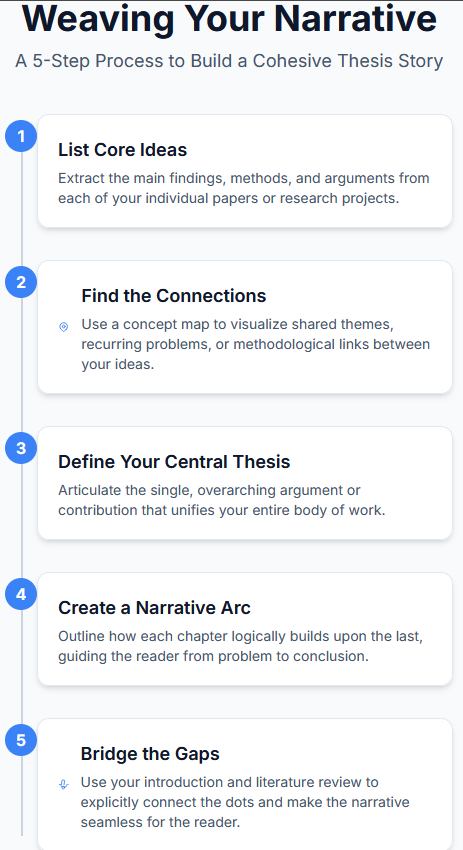For many PhD students, the words "thesis writing" conjure a feeling of dread. It’s the final hurdle in a long academic journey, a monumental task where the stakes feel incredibly high. Without a clear strategy, the process can quickly devolve into a nightmare—a never-ending cycle of disorganised notes, disjointed drafts, and paralysing stress. You've already invested years in your research; you can't afford to waste time now.
But what if thesis writing didn’t have to be a nightmare? What if it could be a structured, manageable, and even fulfilling process of storytelling?
The key is to shift your perspective from just "writing" to "architecting." By adopting a strategic approach, you can transform scattered research into a cohesive, powerful narrative. Here is a guide to help you do just that.
Part 1: The Blueprint – Architecting Your Thesis Story
Before you write a single paragraph, you must first become the architect of your entire project. This planning phase is the most critical step, as it creates the foundation upon which everything else is built.
1. Discover Your Structure in Exemplar Theses
You are not the first person to write a thesis in your field. Before you begin, identify 10-15 exemplary theses from your research area. These are not just for inspiration; they are your practical guides. Skim through them, paying close attention to:
- The Introduction: How do the authors frame the problem and set the stage for their work?
- The Literature Review: How do they synthesise existing knowledge to carve out a clear research gap?
- The Overall Architecture: What is the logical flow from one chapter to the next?
This process isn't about copying; it's about understanding the established conventions and successful structures in your discipline so you can design your own.
2. Build a Cohesive Story from Your Research
During your PhD, you likely worked on multiple papers that may not seem directly linked. Your thesis is the opportunity to weave these disparate threads into a single, compelling story.
To do this, lay out the core ideas from each paper and look for the connections. Are there recurring themes, similar methodologies, or an overarching problem that links them? Create a concept map to visualise these connections. This will help you develop a central argument—the core contribution of your entire body of work. Once you have this central theme, you can adjust the introduction and conclusion of each chapter to explicitly show how it contributes to the larger narrative.
Pro Tip: Tell this story out loud to your supervisor and peers. Explaining your narrative arc is the fastest way to find weak links and get feedback to strengthen your overall story. As "The Art of Scientific Writing" reminds us, you can never do this alone.
Weaving Your Narrative
- List Core Ideas: Extract the main findings and methods from each of your papers.
- Find the Connections: Use a concept map to identify shared themes, recurring problems, or methodological links. (Icon: A mind map)
- Define Your Central Thesis: Articulate the single, overarching contribution that unifies all your work.
- Create a Narrative Arc: Outline how each chapter builds upon the last, moving your reader logically toward your conclusion.
- Bridge the Gaps: Use your introduction and literature review to explicitly connect the dots for your reader. (Icon: A bridge connecting two points)
Part 2: The Core Narrative – Crafting a Powerful Introduction
Your introduction is the most important chapter of your thesis. It is not just a summary; it is your chance to make a powerful first impression and convince the examiner that your work is important.
- Hook Your Reader Immediately. Start with a compelling hook—a surprising fact, a thought-provoking question, or a statement that establishes the urgency of your research problem.
- Present Your Problem and Contributions Upfront. Don't make your examiner hunt for the value of your work. State the concrete problem you have solved in 3-4 clear lines. Then, list your 3-4 primary contributions. This immediately establishes the significance of your research.
- Showcase Your Credibility. If parts of your research have been published, mention this in the introduction. This signals to the examiner that your work has already undergone peer review and meets a high standard of quality.
- Visualise the Journey. A PhD thesis is a long document. Help your reader navigate it by including a figure in your introduction—a flowchart, a tree diagram, or a simple numbered list—that visually represents the organisation of your chapters and how they connect.
Part 3: The Execution – From Draft to Polished Document
With a solid blueprint and a compelling introduction, the final phase is about execution and polish.
- Choose the Right Tool for the Job. For a long, complex document like a thesis, tools like LaTeX are designed to handle formatting, references, and content organisation much more effectively than standard word processors. A small-time investment to learn the basics can save you countless hours of formatting headaches later.
- Link Your Chapters Explicitly. Ensure a smooth journey for your reader. Each chapter should feel like a logical continuation of the last. Start each new chapter by briefly referencing the key takeaways from the previous one before explaining the purpose and structure of the current chapter. This creates a seamless flow.
- Seek Feedback Systematically. Don't wait until your entire draft is finished. Send individual chapters to your supervisor as you complete them. Use collaborative tools like Google Docs to get real-time comments, and be proactive in applying the feedback to upcoming chapters.
- Proofread with a Purpose. Typos and formatting errors are distracting and signal a lack of care. Go beyond a simple spell-check. Plan multiple proofreading sessions with breaks in between. Read your thesis out loud to catch awkward phrasing. Check for consistency in font sizes, citation styles, and headings. If possible, hire a professional proofreader or enlist detail-oriented peers for a final review.
Final Thoughts
Writing a thesis is a marathon, but it doesn't have to be a nightmare. By shifting from a mindset of "just writing" to one of strategic design, you can take control of the process. A well-architected thesis that tells a clear and compelling story will not only impress your examiners but also stand as a proud capstone to your years of hard work.
Frequently Asked Questions (FAQ)
- How do I create a "story" if my research papers seem completely unrelated?
Look for a higher-level connection. Perhaps they all use a novel methodology, or they all address different facets of a larger, more fundamental problem in your field. Your story might be about the evolution of your thinking or the development of a particular technique across different applications. - What's the most important thing to look for in an exemplary thesis?
Focus on the structure of the introduction and the transitions between chapters. How does the author create a logical argument that leads to their research question? How do they begin a new chapter to connect it to the previous one? This structural "scaffolding" is often more valuable than the specific content. - I'm not familiar with LaTeX. Is it really worth the effort to learn mid-thesis?
For many, yes. The initial learning curve (which can be just a few hours for the basics) is often offset by the time saved on formatting, especially with references, figures, and tables. If you are constantly fighting with your word processor's formatting, the switch may be a worthwhile investment.


